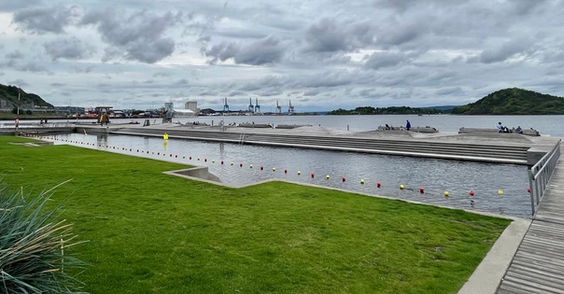STUDIO
URBAN BATHING IN COPENHAGEN
-
University of Bordeaux (Laboratoire LACES)
-
Bordeaux National School of Architecture and Landscape (Laboratoire PAVE)
Now a huge popular success, urban bathing was originally part of a wider strategy for the Danish capital to turn its harbour back into an urban centre by offering its inhabitants a peaceful living environment close to nature. This desire to restore a sense of nature to the city was accompanied by recreational use of the water: tourism, holidays, yachting, promenading, kayaking, and, of course, swimming and bathing.
Since the inauguration of the initial harbour bath in 2002, the practice of "urban bathing" has flourished in Copenhagen. This has not only expanded the scope of recreational activities that could be enjoyed in one's apartment, but has also reinvented the place and role of the body in interaction with others and created the conditions for the creation of new everyday places. Presently, in 2023, Copenhagen has 14 official harbour baths with a variety of architectural styles, making the city an ideal place to investigate what it means to 'bathe in the city'.
Although the harbour bath supports bodily practices associated with leisure or maintenance, it appears that this space was not solely intended for satisfying the inhabitants' desire for summer idleness and recreation. Instead, it has become a gathering place for residents to engage in contemplation and sensory exaltation, to experiment with co-presence, and to indulge in a variety of residential practices associated with the Scandinavian active-body lifestyle.
Copenhagen's harbour baths now take on diverse architectural forms. Certain ones are designed as 'urban beaches': places to swim, but also places to walk, to meet friends, to rest, to sunbathe or to expose oneself to others. Meanwhile, others are meant for the public who value safety and sport, with more prescribed use in line with the inflexible design akin to a conventional swimming pool.
Finally, with the democratization and massification of access to water, the study of harbour baths raises questions about the appropriation of the quays as a place to live by the resident subject. Some people want to be able to bathe wherever they want, even if it means doing so at the bottom of their dwelling, where bathing is not permitted. Playing with the regulatory limits of bathing areas can then become the challenge for residents in their quest for the freedom to make the city their own.
APPROACH
Urban bathing in Copenhagen reflects a radical movement to renew the city and its waterfront. Initially a recreational activity that changed the image of the Danish capital in the eyes of the world, it has now become an integral part of the lives of its inhabitants, changing the way they use the city. This research continues to show us the new ways in which city dwellers are appropriating their immediate natural environment.
In this contemporary urban dynamic, the image of the body is reinforced and displayed in urban space. Waterfront areas offer residents a chance to unwind and bare their skin to the sun, ground, wind, and otherness. Bathing in the city is a way of identifying with the same Nordic culture, which is particularly expressed through a relaxed relationship with nudity. We argue that it is through this power of identification that the bath is enthroned as a 'place': the harbour bath exists as a surface, spatially delimited and discreetised by its boundaries and characteristic architecture. However, it is also sometimes the case that it exists only through the bathing practices of individuals: it is then through the representation of a recreational and hedonic seaside imaginary that the bath begins to exist. In this way, it can be discretised.
The harbour bath stands out as its own entity, both spatially and socially. It is a place of social interaction, an expression of identity and belonging to the same world, that of the Danish way of life of the active body. Consequently, the harbour bath appears as a space that is invested, qualified and produced by the daily practice of its inhabitants, which consists of activities, habits, memories and symbols. Harbour baths are not sports facilities in their original definition. Instead, they are open spaces where everyday urban life takes place. Moreover, the baths illustrate that the active Danish body is not only focused on physical activity, but also uses the facilities for well-being, sociability, self-promotion, and visibility.
In essence, the harbour baths serve as a showcase of what it means to "live" in Copenhagen in 2023. As a place to party in the summer and a place to live in the neighbourhood in the winter, they offer many opportunities to make these waterside spaces your own. Nevertheless, this appropriation leads to overuse and conflicts of use, especially in the summer, which the City of Copenhagen is trying to resolve in various ways.
Our general research problem is to confront harbour bathing (as a spatialised urban element) and bathing (as an urban practice): while the first one embodies new ways of living in the city, the second one questions the current rules of governance in the harbour of Copenhagen.














































